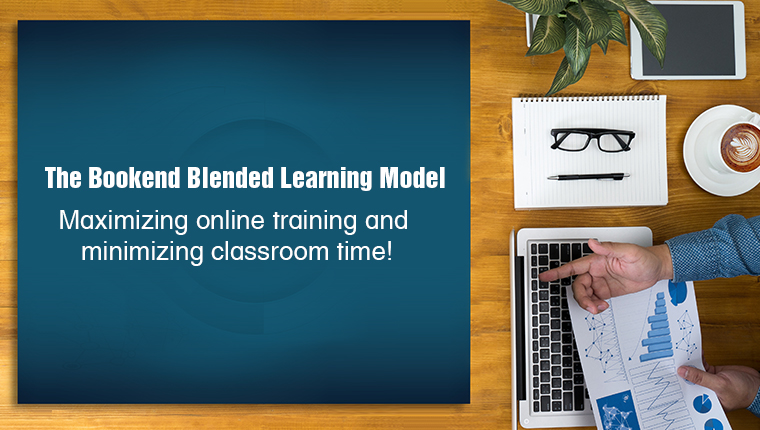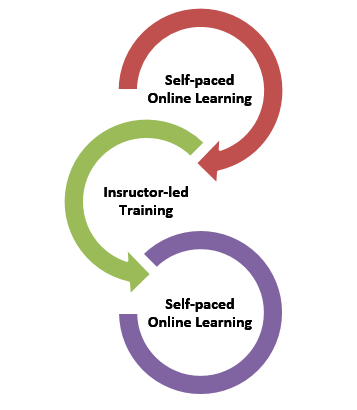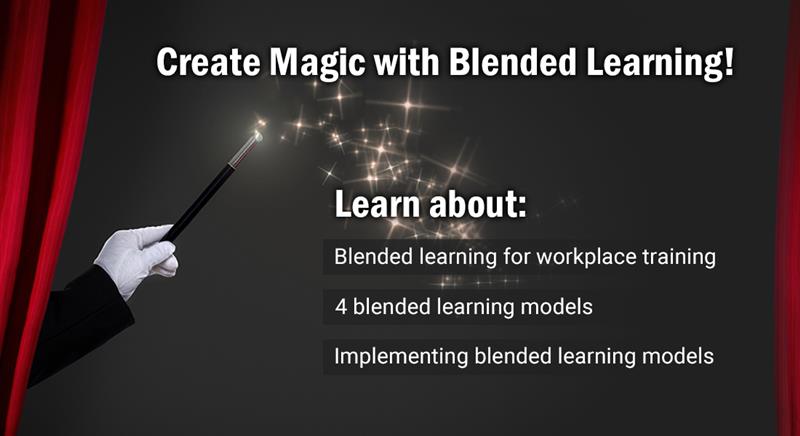The Bookend Blended Learning Model: What’s it All About?

Most of us are aware that blended learning is a mix of face-to-face and online training programs. However, did you know that there are different models of delivery in blended learning? The bookend blended learning model is one among them, and here we’ll explore what this model of blended learning delivery is all about.
3 Phases in the Bookend Blended Learning Model
Phase 1: Planning and preparing to gain basic knowledge
Phase 2: Interacting and focusing on practicing skills
Phase 3: Applying learning and providing performance support
What is the Bookend Blended Learning Model?
The bookend blended learning model is a 3-phase approach where face-to-face training is wrapped around online training methodologies. According to The E-Learning FIELDBOOK by Nick van Dam, learning in the bookend model begins and ends with online training, with a brief interaction in the classroom or virtual classroom in-between.

One key advantage of following the bookend blended learning model is cutting down on classroom or face-to-face training, thereby reducing the time participants spend away from work.
Phases in Bookend Blended Learning Model
There are three phases in the bookend blended learning model.
Phase 1: Planning and Preparing to Gain Basic Knowledge
This phase of blended learning is completed online. Pre-assessments to evaluate learners’ prior knowledge, and taking the learner through introductory concepts are all part of this phase. What can you as a learning and development professional do to facilitate this phase of the bookend blended learning model?
Simple. Make use of self-paced e-learning modules. Also, let learners read articles related to the training content and take online self-assessments that measure their current or prior knowledge on the content. This can help training managers decide if additional explanation on the content is required in the classroom training program, which is the next phase in bookend blended learning.
The learning goal in the first phase is to acquire and assess knowledge.
Phase 2: Interacting and Focusing on Practicing Skills
The second phase of the bookend blended learning model is delivered as classroom training or a virtual face-to-face interaction with the instructor. The advantage of blended learning is that learners get a chance to interact with the instructor and their peers, and are not isolated as in the case of asynchronous learning.
The classroom training program is focused on practicing skills and covering complex topics that are part of the training program. This phase also gives learners a chance to interact with the instructor as well as peers. Group discussions and role plays can be included as part of the classroom training.
The learning goals in the second phase are primarily aimed at practice and collaboration. It is possible to deliver guided learning in this phase as the learner gets to interact with the instructor and clarify questions if any in the topics covered in the first phase of the blended training program.
Phase 3: Applying Learning and Providing Performance Support
The last phase in the bookend blended learning model is again delivered as self-paced learning. By the time learners move to this phase of the training program, they have already acquired sufficient knowledge on the training content. Now it’s time to apply the knowledge they have gained.
The learning goal in the last phase is performance support. This part of the learning experience is often ignored in training programs. Employees go through training programs, but are they able to utilize the knowledge gained? Training does not make sense if learners are unable to apply it on their job. Give learners effective performance support that enables them to complete tasks at the workplace. It would help if learners are given additional reference material on the training content. For example, they can go through a video that demonstrates how to perform a task, an infographic that quickly lists the steps in a process, or use a reference guide in the PDF format. They can also participate in discussion boards to gain more knowledge from experts on the subject.
According to an article from AMA, blended learning models can address that nagging concern on the transfer of training. By promoting connections and conversations, organizations can extend training beyond the classroom and into the workplace through concepts such as e-coaching and online communities.
One of our clients who required a blended learning program to train its employees on a document management software wanted a ready reckoner that learners could refer to even after the training program was complete. We designed quick reference guides (QRG) for participants that acted as a performance support tool to guide learners with the software. The QRG also helped reinforce learning that was completed in the classroom.
Example of Bookend Blended Learning
Here’s an example. Consider a training program for new managers. The aim of the training program is to help new managers develop leadership skills. Team building exercises and role plays are part of the training program.
The bookend blended learning model divides this training program into 3 phases, where the classroom training program is preceded and followed by self-paced, online learning programs.
- In the first phase, technology-enabled learning is leveraged to deliver basic information on the training content. Introductory content required for leadership training is covered in this phase. For example, concepts such as the definition of leadership, the theories of leadership, key skills and characteristics of effective leaders are a few topics that can be covered through self-paced online learning.
- In the second phase, the face-to-face program delivers a substantial learning experience as it takes care of leadership skill development through role plays, discussions, and other activities that promote culture building, networking with peers, and senior leadership team members.
- In the third phase, post-training assessment and reinforcement of learning is taken care of so that the leadership skills are applied at work.
While this is just one example, there are many other training programs that can be delivered through a bookend blended learning model.
When you are looking at gaining the maximum from minimum classroom time, leveraging online training resources effectively, and speeding up the transfer of employees’ knowledge from training to job skills; the bookend blended learning model is a good option to consider. If you’d like to know how to use blended learning to give employee performance a quick boost, don’t forget to download our eBook on ‘Blended Learning’.



![What Exactly is the Bookend Blended Learning Model? [SlideShare]](https://blog.commlabindia.com/hubfs/Imported_Blog_Media/blended-learning-bookend-model-slideshare.jpg)
![6 Factors that Impact your Choice of Blended Learning Model [Infographic]](https://blog.commlabindia.com/hubfs/Imported_Blog_Media/blended-learning-model-influencing-factors.jpg)
